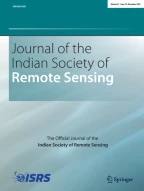Abstract
Remote sensing techniques using satellite imagery have proved to be an indispensible tool in morphometric analysis and groundwater studies. In the present area, morphometric analysis using temote sensing techniques have been carried out in Chaka river sub-basin of Manbazar Block, Purulia district, West-Bengal, which is one of the most drought affected area in West-Bengal. The parameters worked out include Bifurcation ratio (Rb), Stream length (Lu). Form factor (Rf), Circulatory ratio (Rc), and Drainage density. The morphometric analysis suggests that the area is covered by fractured, resistant, permeable rocks, the drainage network not so affected by tectonic disturbances.
Using satellite imageries of LANDSAT and IRS, different hydrogeomorphological units have been delineated. The study shows that moderately weathered pediplains and valley fills are good prospective zones for groundwater exploration.
Similar content being viewed by others
References
Horton R E (1945). Erosional development of streams and their drainage basins; Hydrophysical approach to quantitative morphology. Bull. Geol. Soc. Am., 56:275–370.
Schumm S A (1956). Evolution of drainage systems and slopes in bad lands at Perth Amboy, New Jersey: Bull. Geol. Soc. Am., 67:597–646.
Strahler A N (1964). Quantitative geomorphology of basins and channel networks, Handbook of Applied Hydrology (Ed. Ven Te Chow). McGraw Hill Book Company, New York.
Author information
Authors and Affiliations
About this article
Cite this article
Nag, S. Morphometric analysis using remote sensing techniques in the chaka sub-basin, purulia district, West Bengal. J Indian Soc Remote Sens 26, 69–76 (1998). https://doi.org/10.1007/BF03007341
Issue Date:
DOI: https://doi.org/10.1007/BF03007341
